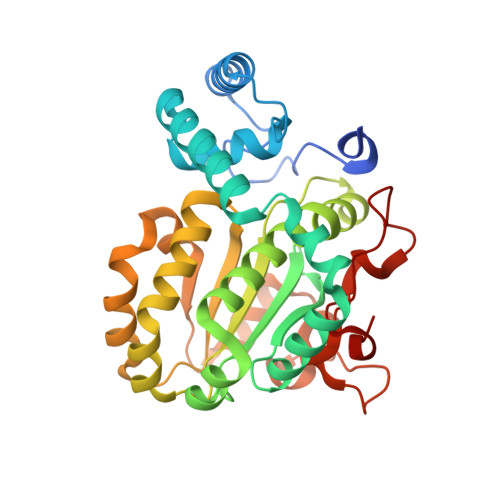Resurrection of a functional phosphatidylinositol transfer protein from a pseudo-Sec14 scaffold by directed evolution.
Schaaf, G., Dynowski, M., Mousley, C.J., Shah, S.D., Yuan, P., Winklbauer, E.M., de Campos, M.K., Trettin, K., Quinones, M.C., Smirnova, T.I., Yanagisawa, L.L., Ortlund, E.A., Bankaitis, V.A.(2011) Mol Biol Cell 22: 892-905
- PubMed: 21248202
- DOI: https://doi.org/10.1091/mbc.E10-11-0903
- Primary Citation of Related Structures:
3Q8G - PubMed Abstract:
Sec14-superfamily proteins integrate the lipid metabolome with phosphoinositide synthesis and signaling via primed presentation of phosphatidylinositol (PtdIns) to PtdIns kinases. Sec14 action as a PtdIns-presentation scaffold requires heterotypic exchange of phosphatidylcholine (PtdCho) for PtdIns, or vice versa, in a poorly understood progression of regulated conformational transitions. We identify mutations that confer Sec14-like activities to a functionally inert pseudo-Sec14 (Sfh1), which seemingly conserves all of the structural requirements for Sec14 function. Unexpectedly, the "activation" phenotype results from alteration of residues conserved between Sfh1 and Sec14. Using biochemical and biophysical, structural, and computational approaches, we find the activation mechanism reconfigures atomic interactions between amino acid side chains and internal water in an unusual hydrophilic microenvironment within the hydrophobic Sfh1 ligand-binding cavity. These altered dynamics reconstitute a functional "gating module" that propagates conformational energy from within the hydrophobic pocket to the helical unit that gates pocket access. The net effect is enhanced rates of phospholipid-cycling into and out of the Sfh1* hydrophobic pocket. Taken together, the directed evolution approach reveals an unexpectedly flexible functional engineering of a Sec14-like PtdIns transfer protein-an engineering invisible to standard bioinformatic, crystallographic, and rational mutagenesis approaches.
Organizational Affiliation:
Department of Cell and Developmental Biology, Lineberger Comprehensive Cancer Center, University of North Carolina School of Medicine, Chapel Hill, NC 27599, USA. gabriel.schaaf@zmbp.uni-tuebingen.de
















